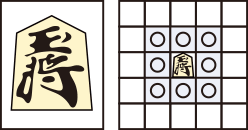How to Play Shogi / Japanese Chess / 将棋

Shogi, also known as Japanese Chess, is the most popular chess variant native to Japan and has been around in its current form since the 16th century. One of the most exciting aspects of Shogi, compared to international chess, is the ability to return captured pieces to the board as your own. This allows for a highly dynamic game resulting in very few draws.
Equipment
The board is composed of rectangles in a grid of 9 “ranks” (rows) and 9 “files” (columns). Players move their pieces within these rectangles. With the exception of the king, pieces are not distinguished by color but by their orientation — Each piece always points toward the opponent. On the front side in black, identifying the piece, are Chinese characters used in Japanese (kanji). On the reverse side, with the exception of the king and gold general, are one or two other kanji in red. The red kanji indicate a piece that has been promoted and has gained an increased power of movement.
Arrangement
The starting positions of the pieces are arranged as shown below.
1. Back row (closest to you): Drop the pieces in this order, from left to right: Lance, Knight, Silver General, Gold General, King (center), Gold General, Silver General, Knight, and Lance.
2. Second row: Drop the Bishop on the second square from the left and the Rook on the second square from the right.
3. Third row: Drop all nine Pawns across the row, one in each square.
All pieces should point toward your opponent with their unpromoted sides facing up.

Pieces
 King, "Osho", 王將A king can move one square in any direction.. |
 Opposing King, "Gyokusho", 玉將Same as above. |
 Gold General ("Gold"), "Kinsho", 金将A gold general can move one square in any direction except diagonally back. |
 Silver General ("Silver"), "Ginsho", 銀将A silver general can move one square diagonally any direction or one space |
 Promoted Silver, "Narigin", 成銀Moves like a Gold General. |
 Knight, "Keima", 桂馬A knight can jump one square forward, plus one square diagonally forward. It is the only piece allowed to jump other pieces in its path. |
 Promoted Knight, "Narikei", 成桂Moves like a Gold General. |
 Lance, "Kyosha" 香車A lance can move any number of free squares directly forward. It cannot move in any other direction. |
 Promoted Lance, "Narikyo" 成香Moves like a Gold General. |
 Bishop, "Kakugyo" 角行A bishop can move any number of free squares in any diagonal direction. |
 Promoted bishop ("Horse"), "Ryuma" 龍馬Moves as a Bishop or as a King. |
 Rook, "Hisha" 飛車A rook can move any number of free squares forward, backward, left or right. |
 Promoted Rook ("Dragon"), "Ryuo" 龍王Moves as a Rook or as a King. |
 Pawn, "Fuhyo" 歩兵A pawn can only move one square forward. |
 Promoted Pawn, "Tokin" と金Moves like a Gold General. |
Gameplay
Shogi is a two-player strategy game similar to chess, where the goal is to capture your opponent’s king by putting it in checkmate. Each player takes turns moving one piece at a
time. A piece moves according to its abilities, and you capture an opponent’s piece by landing on its square. Captured pieces can be reused later in the game by dropping them back onto the board as your own.
On your turn, instead of moving a piece, you can drop a captured piece on any empty square, starting with its unpromoted side up.
However, there are a few rules for dropping pieces:
- You can’t drop a pawn in a column that already contains your unpromoted pawn. (If your pawn in that column has already been promoted, you may drop another
unpromoted pawn.) - You may not drop a pawn that immediately delivers checkmate. Other pieces may be dropped to checkmate.
- You cannot drop a piece where it has no legal moves:
• Pawns on the last row.
• Knights on the last or second-to-last row.
• Lances on the last row
Each player has a promotion zone, which is the farthest three rows on the opponent’s side. If one of your pieces moves into, out of, or within this zone, you can promote it at the end of your turn by flipping it over to reveal its stronger side. Pawns, lances, and knights must promote when they reach the last rows where they would otherwise have no legal moves. Promotion gives pieces new abilities and adds depth to your strategy.
The game ends when one player checkmates the opponent’s king, called "詰み" (tsumi), meaning the king has no legal moves to escape capture. If the king is threatened with capture on the next move, it's called a "check," which can be announced with "王手" (oute). If the same board position repeats four times with the same player to move, the game ends in a draw—except when one player is giving perpetual check, in which case that player loses. Shogi is a game of deep strategy and foresight, where each move can turn the tide. Master the art of careful planning and the strategic use of captured pieces to outwit and outmaneuver your opponent. Tip: Try to control the center and save captured
pieces to surprise your opponent later!
Shop for a Shogi Japanese Chess Set
Version: 2-25
© 2025 Yellow Mountain Imports, Inc.
